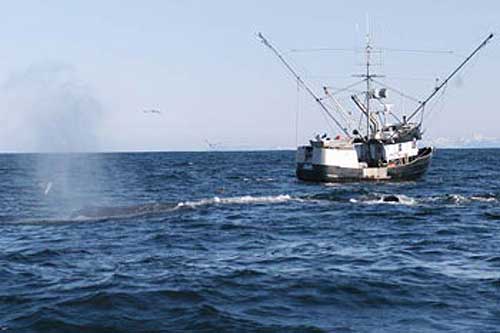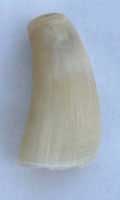 by Sonya Senkowsky May 28, 2004 Alaska - In the novel Moby Dick, Captain Ahab pursues a giant sperm whale in revenge for taking his leg. That was fiction. In real-life, some Alaska sperm whales would rather take a bite out of fishermen's catch. Author Herman Melville, who immortalized sperm whales in his classic story, Moby Dick, attributed a sinister intelligence to the mysterious animals.  Photo Courtesy Jan Straley
Straley said, "Sperm whales are cueing in on some aspect of fishing behavior and then waiting for these fish to be brought up to the surface on longline gear, and then at some point in the water column the whales take the fish off the longline gear, off the hooks." Scientists don't yet know how widespread the behavior is. But one federal survey estimates that, when sperm whales do start chowing down, they can take more than a 20 percent bite of a fisherman's catch. The behavior first came to Straley's attention in the mid-1990s, when several fishermen asked for her help. "It didn't surprise me, I mean, sperm whales are pretty clever," said Straley. On the other hand, these school bus-size giants do seem awkwardly designed for stealing comparatively small fish from hooks. And their supersized, box-shaped heads contain teeth only along a thin lower jaw. Still, somehow, the animals appear to be picking and choosing their favorite prey, even leaving behind less-appetizing fish in favor of sablefish or halibut, says Straley.
Other times, the only evidence fishermen find are hooks left straight and bare. Even whale biologist Straley has a hard time imagining how the whales might be doing it. Straley said, "We don't know how they're taking fish off the gear. It's amazing to think that they could even do it when you look at their head. They have that great big head and that little tiny lower jaw. And it's completely unfathomable how they're getting these fish." Researchers hope to learn more about how the whales interact with Alaska's commercial longline fishermen. With funding from the North Pacific Research Board, Straley and colleagues are working with ten Alaska fishing boats, using acoustic tools to listen to sperm whales underwater and taking genetic samples to identify the culprits, says Straley. "My part of this project is to look at who's doing it in terms of the whales. What whales are responsible for this depredation, and also to get genetic samples to help with population structure and identify them. Is it all males or is it all females? We don't really know who these whales are that are doing the depredation, or how many," Straley said. The goal is to help fishermen avoid inviting any more unwanted dinner guests. Straley said, "So we're looking at the cues the whales are using that attracts them to these vessels. We're assessing all aspects of fishing behavior and then we're going to look and test some deterrents." At stake is more than a few lost fish. Because sperm whales are an endangered species, human activity around them is restricted by federal law. A partnership between fishermen and researchers, called the Southeast Alaska Sperm Whale Avoidance Project, hopes to find solutions that benefit both the sperm whales and fishermen.
Story & photographs courtesy of:
|
|||

